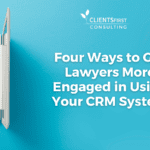Go with the Flow of Data Cleaning – Don’t Drown in Bad Data

All CRM contact records are not created equal. By segmenting contact data into manageable pieces, your data cleaning process will be more manageable, and you can better measure progress.
Have you ever heard the saying, “No man ever steps into the same river twice”? Because a river’s water is constantly flowing and changing, the water you step in today will be different from yesterday. The same is true for the data in your CRM system: people are constantly changing roles, relocating, retiring; companies are opening, closing, moving and merging. On top of that, new data isn’t always entered correctly. As a result, a database with clean, correct information today will not necessarily be accurate tomorrow. Over time, this bad data can compound exponentially, resulting in ineffective marketing, events and communication campaigns because as your data degrades, you reach fewer members of your target audience.
For professional services firms, poor data quality in your CRM system can also translate into a decline in system adoption. Once your professionals see bad data, they won’t trust the system as a whole and ultimately may outright refuse to use it. This is why we stress the importance of ongoing data cleaning.
Data Cleaning Dos and Don’ts
Simply put, data cleaning involves identifying incorrect, incomplete and/or dated data in your systems and correcting and enhancing it. If you have a large database with thousands, or hundreds of thousands, of records, the data quality process can seem daunting and overwhelming.
While there’s no magic bullet or quick fix for poor data quality, ignoring data problems until there’s a crisis is not a strategy. Good data quality requires ongoing effort that never ends. The good news is that this means you have forever to get better at it. So, start now. Begin by assessing the scope of your data quality issues. Then, because it’s not always cost-effective or even possible to clean all your data, start by focusing on the highest priority projects.
Identify and Prioritize Your Most Important Data
All contact records are not created equal. For instance, client data is typically more important than non-client data. Additionally, individuals who have recently subscribed to your communications or attended an event are more important than those who last interacted with your firm years ago. Whatever segmenting scenario you select, it’s important to find ways to divide your contact data into manageable pieces because it makes the process more manageable and allows you to better measure progress.
Eliminate Stagnant Records
Related to prioritizing your data, don’t be hesitant about removing records that have been inactive for an extended period. Search your system for contacts that have not been updated for a few years, are not related to or known by any of your professionals, are not clients or alumni, and have not opened a communication or invitation in two to three years. Chances are good these records are not only outdated but also may not be worth the resources it would take to update them. Identify these records and consider removing them from the system. Less mess in your database makes cleanup a bit more manageable.
Do you have data quality issues? Feel free to post a comment, or reach out to us at info@clientsfirstconsulting.com.
Want to know more about managing your CRM data quality? Read Go with the Flow of Data Cleaning Part 2 – Planning for Data Quality.
For more than a decade, the team at CLIENTSFirst Consulting has been helping professional services firms and other organizations successfully select and implement CRM and eMarketing systems and improve Data Quality to maximize value, adoption and return on investment. If you need help achieving CRM Success, please contact us at 404-249-9914 or Info@ClientsFirstConsulting.com.







